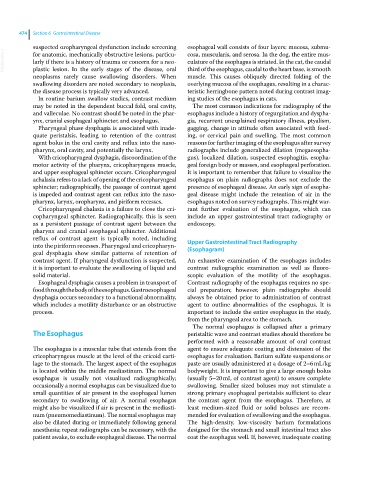Page 506 - Clinical Small Animal Internal Medicine
P. 506
474 Section 6 Gastrointestinal Disease
suspected oropharyngeal dysfunction include screening esophageal wall consists of four layers: mucosa, submu
VetBooks.ir for anatomic, mechanically obstructive lesions, particu cosa, muscularis, and serosa. In the dog, the entire mus
culature of the esophagus is striated. In the cat, the caudal
larly if there is a history of trauma or concern for a neo
plastic lesion. In the early stages of the disease, oral
muscle. This causes obliquely directed folding of the
neoplasms rarely cause swallowing disorders. When third of the esophagus, caudal to the heart base, is smooth
swallowing disorders are noted secondary to neoplasia, overlying mucosa of the esophagus, resulting in a charac
the disease process is typically very advanced. teristic herringbone pattern noted during contrast imag
In routine barium swallow studies, contrast medium ing studies of the esophagus in cats.
may be noted in the dependent buccal fold, oral cavity, The most common indications for radiography of the
and valleculae. No contrast should be noted in the phar esophagus include a history of regurgitation and dyspha
ynx, cranial esophageal sphincter, and esophagus. gia, recurrent unexplained respiratory illness, ptyalism,
Pharyngeal phase dysphagia is associated with inade gagging, change in attitude often associated with feed
quate peristalsis, leading to retention of the contrast ing, or cervical pain and swelling. The most common
agent bolus in the oral cavity and reflux into the naso reasons for further imaging of the esophagus after survey
pharynx, oral cavity, and potentially the larynx. radiographs include generalized dilation (megaesopha
With cricopharyngeal dysphagia, discoordination of the gus), localized dilation, suspected esophagitis, esopha
motor activity of the pharynx, cricopharyngeus muscle, geal foreign body or masses, and esophageal perforation.
and upper esophageal sphincter occurs. Cricopharyngeal It is important to remember that failure to visualize the
achalasia refers to a lack of opening of the cricopharyngeal esophagus on plain radiographs does not exclude the
sphincter; radiographically, the passage of contrast agent presence of esophageal disease. An early sign of esopha
is impeded and contrast agent can reflux into the naso geal disease might include the retention of air in the
pharynx, larynx, oropharynx, and piriform recesses. esophagus noted on survey radiographs. This might war
Cricopharyngeal chalasia is a failure to close the cri rant further evaluation of the esophagus, which can
copharyngeal sphincter. Radiographically, this is seen include an upper gastrointestinal tract radiography or
as a persistent passage of contrast agent between the endoscopy.
pharynx and cranial esophageal sphincter. Additional
reflux of contrast agent is typically noted, including Upper Gastrointestinal Tract Radiography
into the piriform recesses. Pharyngeal and cricopharyn (Esophagram)
geal dysphagia show similar patterns of retention of
contrast agent. If pharyngeal dysfunction is suspected, An exhaustive examination of the esophagus includes
it is important to evaluate the swallowing of liquid and contrast radiographic examination as well as fluoro
solid material. scopic evaluation of the motility of the esophagus.
Esophageal dysphagia causes a problem in transport of Contrast radiography of the esophagus requires no spe
food through the body of the esophagus. Gastroesophageal cial preparation; however, plain radiographs should
dysphagia occurs secondary to a functional abnormality, always be obtained prior to administration of contrast
which includes a motility disturbance or an obstructive agent to outline abnormalities of the esophagus. It is
process. important to include the entire esophagus in the study,
from the pharyngeal area to the stomach.
The normal esophagus is collapsed after a primary
The Esophagus peristaltic wave and contrast studies should therefore be
performed with a reasonable amount of oral contrast
The esophagus is a muscular tube that extends from the agent to ensure adequate coating and distension of the
cricopharyngeus muscle at the level of the cricoid carti esophagus for evaluation. Barium sulfate suspensions or
lage to the stomach. The largest aspect of the esophagus paste are usually administered at a dosage of 2–6 mL/kg
is located within the middle mediastinum. The normal bodyweight. It is important to give a large enough bolus
esophagus is usually not visualized radiographically; (usually 5–20 mL of contrast agent) to ensure complete
occasionally a normal esophagus can be visualized due to swallowing. Smaller sized boluses may not stimulate a
small quantities of air present in the esophageal lumen strong primary esophageal peristalsis sufficient to clear
secondary to swallowing of air. A normal esophagus the contrast agent from the esophagus. Therefore, at
might also be visualized if air is present in the mediasti least medium‐sized fluid or solid boluses are recom
num (pneumomediastinum). The normal esophagus may mended for evaluation of swallowing and the esophagus.
also be dilated during or immediately following general The high‐density, low‐viscosity barium formulations
anesthesia; repeat radiographs can be necessary, with the designed for the stomach and small intestinal tract also
patient awake, to exclude esophageal disease. The normal coat the esophagus well. If, however, inadequate coating

